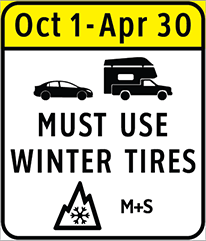
Fall’s arrival leads to Oct. 1 winter tire requirement.
Whether driving for work or pleasure, crash risk increases as season changes. Even though we’re only a few days into fall, it’s not too early to start thinking about winter — at least as far as your tires are concerned.
B.C. law requires winter tires on many provincial highways starting on October 1. That’s the same day Road Safety at Work launches its annual Shift into Winter safety awareness campaign.
“Winter tires aren’t just for snow and ice. They also provide better traction in rain and the cooler temperatures we’re already seeing at night,” says Trace Acres, program director of Road Safety at Work, a WorkSafeBC-funded Injury Reduction Initiative. “They’re one of the best safety features on any vehicle at this time of year. Putting them on now, before poor weather really hits, can help keep drivers and their passengers safe.”
Road and weather conditions in fall can change quickly and increase the risk of crashing. Wet, slippery roads can challenge even the most experienced drivers.
Winter tires can help reduce the risk whether you drive for pleasure or for work. To be legal, they need to have at least 3.5 mm of tread. Tires displaying the 3-peaked mountain/snowflake symbol provide better traction and stopping distances when temperatures drop below 7C. Tires with the M+S (mud and snow) symbol also meet the legal requirement.
Designated highways require winter tires or chains from October 1 to March 31. The timeline extends to April 30 for select highways, such as mountain passes and rural routes in high snowfall areas.
How to adjust your driving in fall.
The 16th annual Shift into Winter campaign starts in fall to remind drivers of the need to start preparing themselves and their vehicles for winter. Drivers haven’t dealt with heavy rain, freezing temperatures, ice, snow, and fog for months and need to adjust their driving to suit the conditions.
Even the best tires aren’t enough on their own. Drivers also need to adjust their mindset.
“There’s a misconception that crashes are always the fault of other drivers. We can get a little over-confident in our own abilities,” says Acres.
Driving too fast for the conditions and distracted driving are two of the leading contributors to crashes in B.C. at this time of year. “Both are within your control as a driver,” he adds. “Your driving decisions can affect the lives of other people on the road.”
Drivers can help keep themselves and their passengers stay safe by following these tips from the Shift into Winter campaign:
• Give your vehicle a seasonal check-up. Add anti-freeze and check tire pressure. Inspect brakes, lights, and engine belts. Install winter wiper blades and winter-rated washer fluid.
• Avoid driving when conditions are poor. Before you go, check DriveBC to see what you can expect on your route.
• Slow down. Posted speed limits are set for ideal conditions. Fall and winter conditions are not ideal.
• Leave at least four seconds of distance between your vehicle and the one in front of you. Following too close can lead to rear-end crashes on slick roads where stopping can be a problem.
• Put away phones and focus on driving. Drivers are 3.6 times more likely to crash when using a phone while behind the wheel, according to ICBC.
• Keep vehicle lights on at all times. Drivers need to see and be seen.
• Pay attention to instructions in roadside work zones. Flag persons and traffic control devices help you safely travel through uneven surfaces and narrow lanes.
Riskiest time of year for work driving.
For the hundreds of thousands of British Columbians who drive as part of their job, November through January is the most dangerous time of year.
Work-related crashes resulting in injury and time-loss claims during those months increase by 26% compared with the rest of the year, according to WorkSafeBC statistics.
Work driving can be done occasionally, part time, or full time. It includes everything from making deliveries to visiting clients to picking up office supplies.
If you drive on the job, ask your supervisor for winter driving training. Employers are responsible for the safety of employees whenever they drive for any work-related reason.
Shift into Winter is a joint provincial initiative managed by Road Safety at Work and supported by the Winter Driving Safety Alliance.
For more tips on fall and winter driving visit ShiftIntoWinter.ca.
Road Safety at Work
